29/11/2019
Registered Community designs (RCDs) and registered UK designs are used to protect the design of the shape and appearance of the whole or part of a new product. This article looks at a practical, real-life example of how a company has used registered designs to protect the design of a new product.
Apple is known to be a company that derives its competitive edge from the design of its products rather than from their pure technical performance. Put simply, to quote Judge Birss in Samsung Electronics UK v Apple Inc. [2012] EWHC 1882 (Pat), Apple’s products are “cool”.
It is therefore unsurprising that Apple is a prolific filer of registered designs. In 2019 alone, Apple has filed to protect 458 designs in Europe. Apple’s registered Community designs include the likes of watches, tablet computers and user interfaces, to adapters, cases and packaging, through to benches, display units and tables.
The new products
On 10 September 2019 Apple announced the latest editions of its successful iPhone smartphone, the iPhone 11 the iPhone 11 Pro and the iPhone 11 Pro Max. The iPhone 11 is expected to be popular with consumers and so it is likely that third parties may try to copy aspects of its design.
How has the design of the new iPhones been protected?
Three registered Community design applications were filed to protect features of the design of the new iPhone 11 variants. These applications contained a total of eighteen separate registered designs that seek to cover various aspects either in isolation or in combination with other aspects. It is clear that Apple takes the protection of its intellectual property very seriously.
Interestingly, Apple’s registered Community design applications for the iPhone 11 were filed on 4 July 2019 with a priority claim to US design patent applications that were filed on 8 January 2019 and 15 March 2019. This means that the design of each of the iPhone 11 variants was finalised at least six months before they were announced. Six months is a long time to try to keep the design of a new product secret, especially a product as popular as the iPhone. Indeed, in the run-up to the release of the new iPhones, Apple had to deal with a number of leaks of complete and accurate renderings of the new products showing the controversial “notch” and the new camera “bump” housing. However, the novelty and individual character of the iPhone 11 registered Community designs should be secure because of the early priority date afforded by the earlier filed US design patents.
The first iPhone 11 registered Community design – RCD no. 006612479
This registration contains a series of two designs covering the standard iPhone 11.
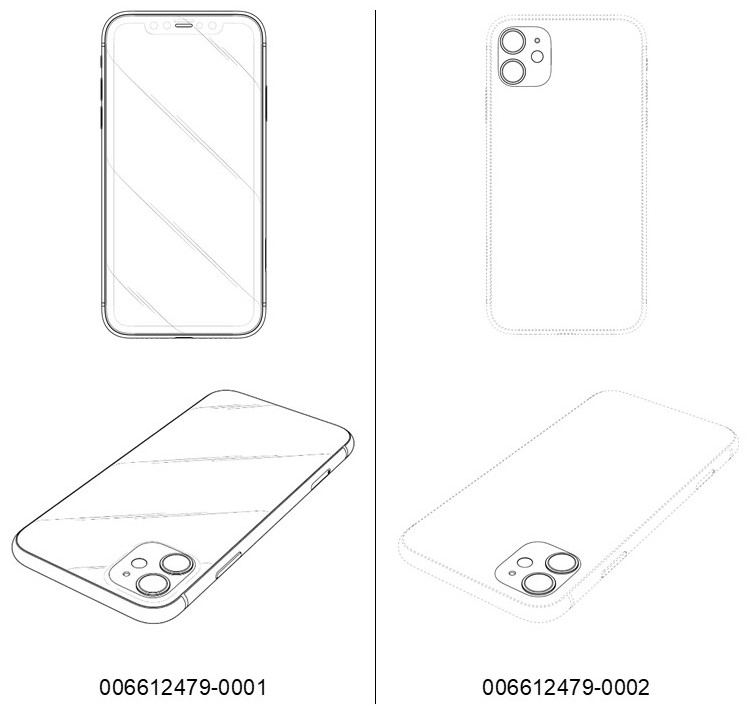
The first design in this registration seeks to protect the overall appearance of the iPhone 11 in combination with the specific details of the device, including the shape and position of the buttons, the shape and arrangement of the camera housing, and the relative dimensions of each feature. Although this registered Community design may have a relatively narrow scope of protection because the drawings show a lot of features, it should be effective in stopping obvious copycat devices from being sold in the EU. This design (and others below) is filed as a colourless line drawing, which prevents the colour scheme of the drawing from limiting the scope of protection of the registration.
The second design seeks to protect the design of the camera “bump” housing on its own. The use of dashed or dotted lines around the phone body shows that Apple is explicitly not claiming protection for the other features of the device in combination with the camera housing. Disclaiming certain features from protection is a common strategy to try to prevent third parties from taking one feature of a new design and applying it to a product that may have a different overall look to the product that the feature was taken from (for example a phone that has a different shaped body).
The second iPhone 11 registered Community design – RCD no. 006611398
This registration contains a series of thirteen designs covering the iPhone 11 Pro and the iPhone 11 Pro Max.
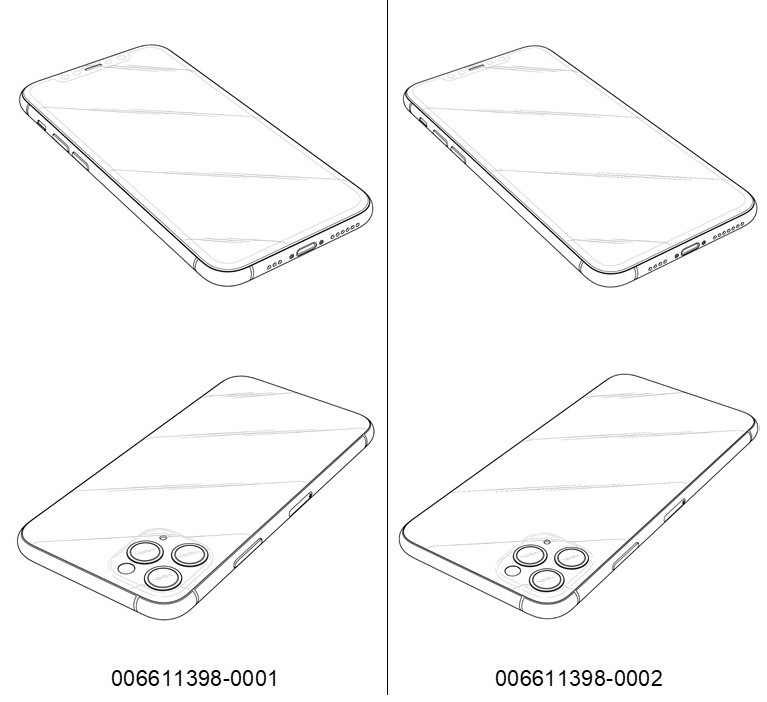
The first design in this registration seeks to protect the overall shape and appearance of the iPhone 11 Pro, and the second design appears to seek to protect the overall shape and appearance of the iPhone 11 Pro Max, which has a larger screen compared to the iPhone 11 Pro. Although at first glance the drawings of the two designs appear to be the same, on closer inspection it can be seen that there are differences– the size of the camera housing relative to the phone body is different in each design, and the drawings of the iPhone 11 Pro Max have four microphone “holes” rather than three.
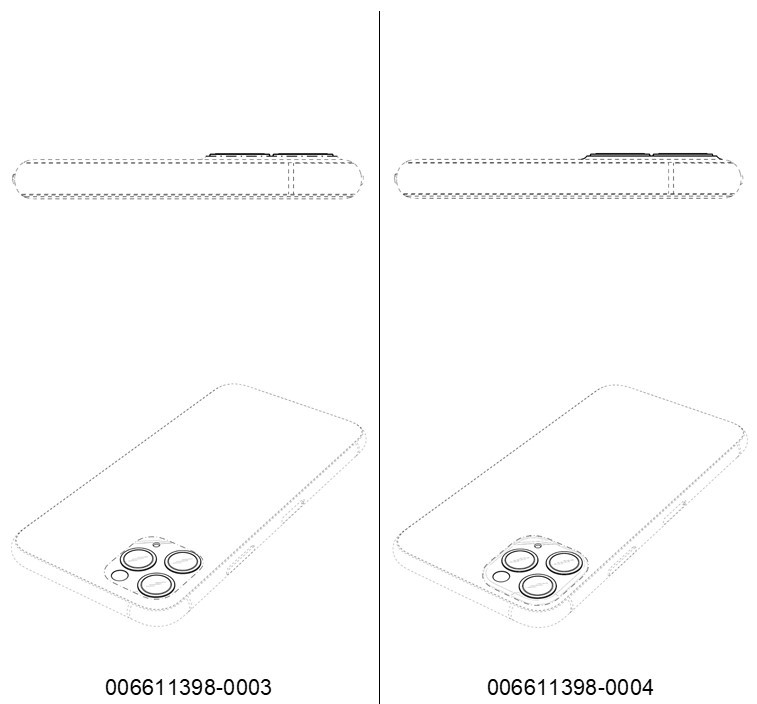
The third and fourth designs in this registration seek to protect the design of the new camera “bump” housing in isolation.
The third design uses dashed lines to disclaim the phone body and the protrusion aspect of the camera housing. This third design covers the shape, appearance and arrangement of the camera lenses and the flash in isolation from the rest of the phone body. The fourth design however claims protection for the protrusion of the camera housing (see the top view of 006611398-0004) in combination with the shape, appearance and arrangement of the camera lenses and the flash.
As discussed above, disclaiming certain features of a design allows protection to be focussed on certain other features in isolation. This common strategy is used to try to prevent a third party from taking a striking feature from a protected product and applying it to a new product. These two registered Community designs could be used to stop a third party from applying the camera “bump” housing to a different phone body.
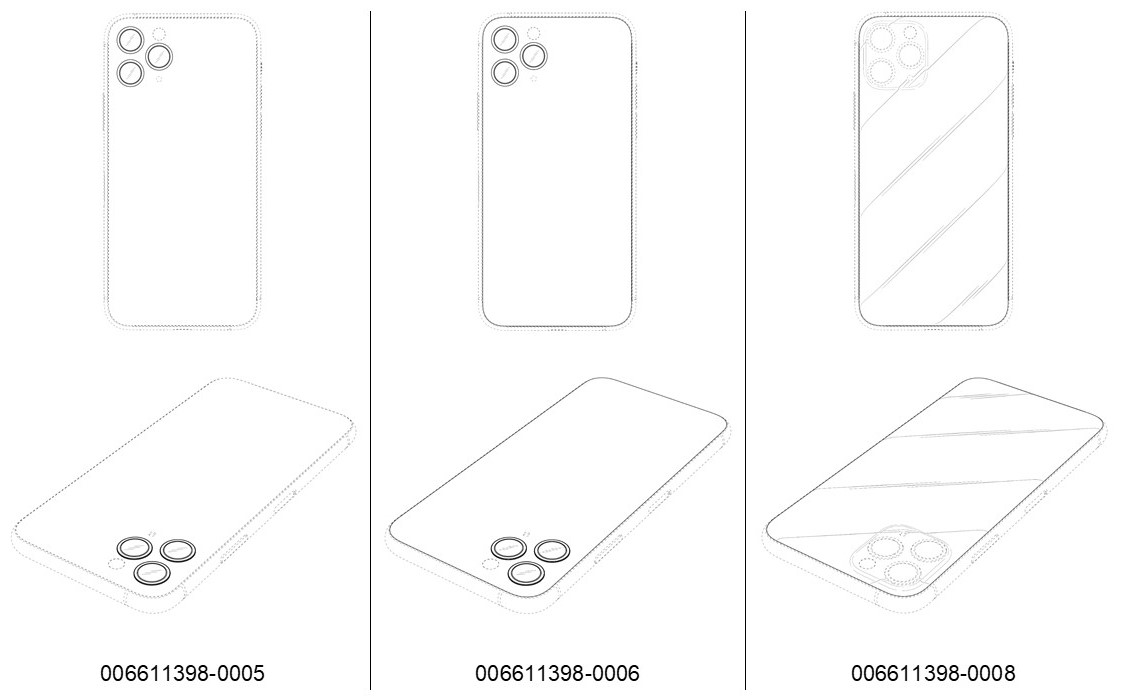
The fifth, sixth, seventh, eighth and ninth designs in this registration seek to protect the design of certain aspects of the camera lenses and the back panel.
The fifth design seeks to protect the specific shape and arrangement of the three camera lenses in isolation. The sixth and seventh designs seek to protect the shape of the camera lenses and the back of the phone body, and the arrangement and positioning of the camera lenses relative to the back of the phone body. The eighth and ninth designs seek to cover the shape and arrangement of the camera “bump” housing relative to the back of the phone body, but without the details of the cameras lenses and the flash. This group of designs appear to be an attempt to protect various specific aspects of the new camera “bump” housing in isolation, in order to try to stop these aspects being copied onto phones having a different body shape.
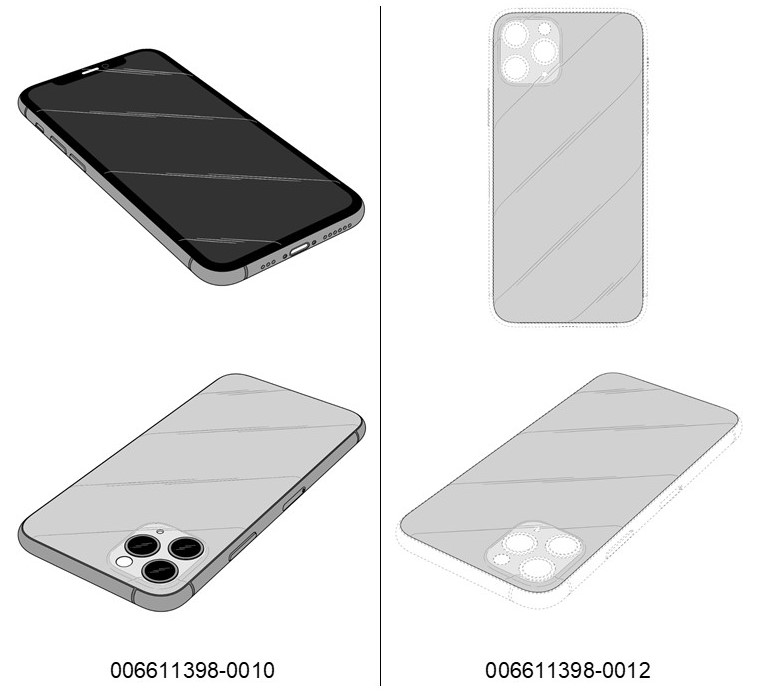
The tenth, eleventh, twelfth and thirteenth designs in this registration seek to protect the design of the phone body.
The tenth and eleventh designs are colour 3d renderings that seek to protect the overall shape, appearance, colour scheme/contrast and materials of the entire phones. These two designs could be very useful in preventing the sale of exact copycat products in the EU. The twelfth and thirteenth designs seek to protect the shape, appearance, colour scheme and materials of the camera “bump” housing in combination with the back of the phone body. These two designs could also seek to protect the slight colour contrast between the back of the phone body and the camera “bump” housing.
The third iPhone 11 registered Community design – RCD no. 006611380
This registration contains a series of three designs also covering the iPhone 11 Pro and iPhone 11 Pro Max.
In these designs, the shading in the drawings does not continue over the camera housing, which consequently provides a slightly different scope of protection to RCD no. 006611398. The different drawings may be the result of the design of the material forming the camera housing being changed at a relatively late stage in the design process.
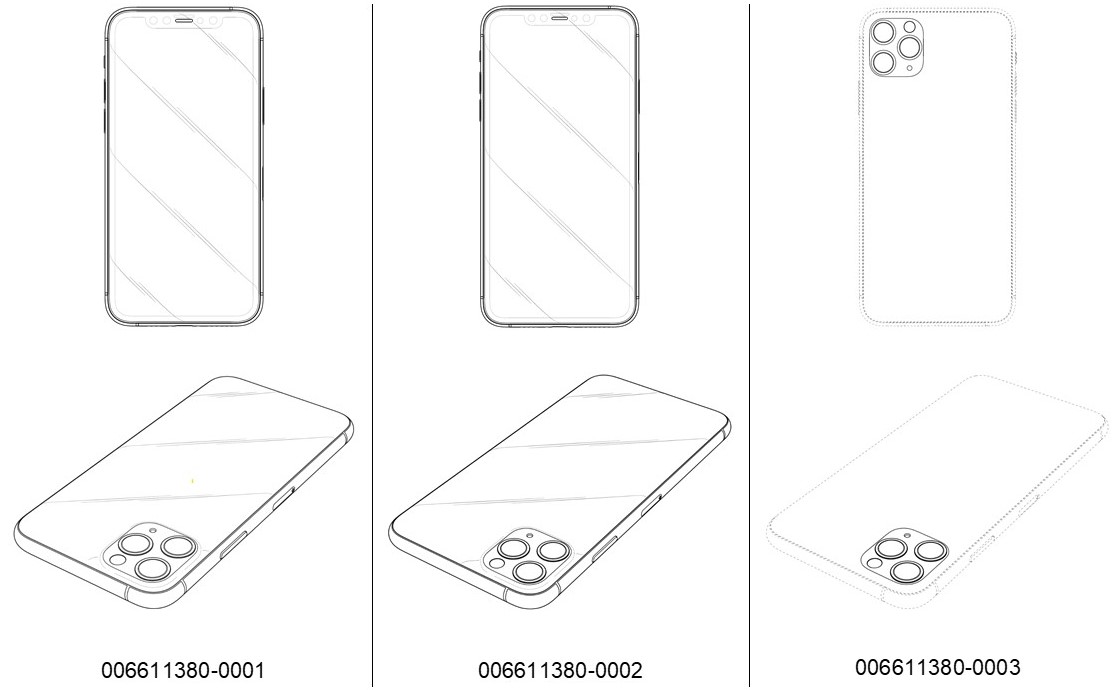
The first design in this registration seeks to protect the overall shape and appearance of the iPhone 11 Pro, while the second design appears to seek to protect the overall shape and appearance of the iPhone 11 Pro Max. These two registered Community designs could be used to stop the manufacture and sale of lookalike products in the EU.
The third design in this registration seeks to protect the design of the camera “bump” housing on its own. This registered Community design could be used to stop a third party from applying the camera “bump” housing to a different phone body.
Deferred publication
The registered Community designs covering the new iPhones were filed at the EUIPO on 4 July 2019, but they were not published until October 2019 or November 2019. This is because deferred publication was requested. Requesting deferred publication can be a very useful tactic because it allows an applicant to seek protection for a design, but to keep the design a secret from competitors or the general public. In this case, it is assumed that Apple wanted to try to keep the design of its new iPhones a secret until when they were officially announced on 10 September 2019.
Take-home points
Registered designs appear to be an essential part of Apple’s worldwide intellectual property strategy. Registered Community designs (RCDs) are particularly convenient for multinational companies such as Apple because just one design registration can be used to stop and/or deter knockoff products from being sold across the whole of the EU.
If you would to discuss how to protect the design of your new products, or for more information about registered designs or other forms of intellectual property protection, such as patents and trade marks, please contact us.
This article is for general information only. Its content is not a statement of the law on any subject and does not constitute advice. Please contact Reddie & Grose LLP for advice before taking any action in reliance on it.


